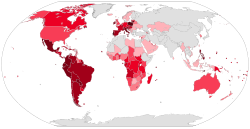
Back الرومانية الكاثوليكية في الفلبين Arabic Simbahan Katoliko sa Filipinas BCL Església Catòlica a les Filipines Catalan Simbahang Katoliko sa Pilipinas CEB Římskokatolická církev na Filipínách Czech Römisch-katholische Kirche auf den Philippinen German Iglesia católica en Filipinas Spanish Église catholique aux Philippines French Katolička Crkva na Filipinima Croatian Gereja Katolik di Filipina ID
This article needs additional citations for verification. (December 2011) |
Catholic Church in the Philippines | |
|---|---|
| Simbahang Katoliko sa Pilipinas (Filipino) | |
 | |
| Type | National polity |
| Classification | Catholic |
| Orientation | Latin |
| Scripture | Bible |
| Theology | Catholic theology |
| Polity | Episcopal |
| Governance | Catholic Bishops' Conference of the Philippines |
| Pope | Leo XIV |
| President | Pablo Virgilio S. David |
| Apostolic Nuncio | Charles John Brown |
| Region | Philippines |
| Language | Latin, Filipino, Native Philippine regional languages, English, Spanish |
| Headquarters | Intramuros, Manila |
| Origin | March 17, 1521 Spanish East Indies, Spanish Empire |
| Branched from | Catholic Church in Spain |
| Separations | Apostolic Catholic Church (1992) |
| Members | 89,000,000 (2023)[1] |
| Tertiary institutions | See list |
| Seminaries | San Carlos Seminary, San Jacinto Seminary |
| Other name(s) |
|
| Official website | www www |
| Part of a series on the |
| Catholic Church by country |
|---|
 |
|
|
As part of the worldwide Catholic Church, the Catholic Church in the Philippines (Filipino: Simbahang Katolika sa Pilipinas), or the Philippine Catholic Church or Philippine Roman Catholic Church, is part of the world's largest Christian church under the spiritual leadership of the Pope in Rome. The Philippines is one of the two nations in Asia having a substantial portion of the population professing the Catholic faith, along with East Timor, and has the third largest Catholic population in the world after Brazil and Mexico.[2] The episcopal conference responsible in governing the faith is the Catholic Bishops' Conference of the Philippines (CBCP).[3]
Christianity, through Catholicism, was first brought to the Philippine islands by Spanish pirates, missionaries and settlers, who arrived in waves beginning in the early 16th century in Cebu by way of colonization. Catholicism served as the country's state religion during the Spanish colonial period; since the American colonial period, the faith today is practiced in the context of a secular state. In 2023, it was estimated that 89 million Filipinos, or roughly 80% of the population profess the Catholic faith.[4]
- ^ Mapa, Dennis S. (February 22, 2023). "Religious Affiliation in the Philippines (2020 Census of Population and Housing)". Philippine Statistics Authority (Press release). Archived from the original on March 10, 2023. Retrieved March 12, 2023.
- ^ "Philippines still top Christian country in Asia, 5th in world". Inquirer Global Nation. December 21, 2011.
- ^ Abellanosa, Rhoderick John (2008). "The CBCP and Philippine Philippine Politics: 2005 and After" (PDF). Asia-Pacific Social Science Review. 8 (1): 73–88. doi:10.3860/apssr.v8i1.707 – via academia.
- ^ Yraola, Abigail Marie P. (February 22, 2023). "Catholics make up nearly 79% of Philippine population". BusinessWorld. Retrieved April 8, 2023.
© MMXXIII Rich X Search. We shall prevail. All rights reserved. Rich X Search